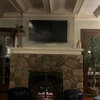Chimeny liner
paddle
18 years ago
More Discussions
Hello, we live in a 30 year old house which has a chimeny that vents for the fireplace and a separate vent for the furnace.
I was told by the chimeny sweep that there should be a metal liner installed on the furnace exhaust(some kind of bylaw in Ontario, Canada,true or not?)
Well, i can see that there is a clay liner sticking out from the top, and i imagine it goes all the way down. Is that not sufficient? Is it diificult to install a liner? Is it expensive? Is it available at the local Homedepot?
thanx
Jim
Toronto, Canada.
........and it's HOT up here!



bytebank
LinC_can
Related Professionals
Batavia Fireplaces · Fort Salonga Fireplaces · Belleville General Contractors · Bowling Green General Contractors · Easley General Contractors · Everett General Contractors · Mentor General Contractors · Milford General Contractors · Natchitoches General Contractors · Newington General Contractors · Schertz General Contractors · Welleby Park General Contractors · Winfield General Contractors · Wyomissing General Contractors · Saint Petersburg Lightingmetal
berlin
metal
berlin
33Cat
mcgillicuddy
mountainstoveguy
berlin
mountainstoveguy
elkimmeg
rick_fireplace_guy
mountainstoveguy
elkimmeg
mainegrower
dopeonplastic
paulfisherman
berlin
dosperado_yahoo_com
sharetheneutral
berlin
sharetheneutral
sharetheneutral
rlh88
mountainstoveguy
mainegrower
rlh88
berlin
mainegrower
worldpower
brickman
nochat66a